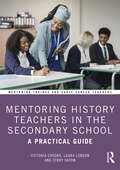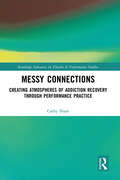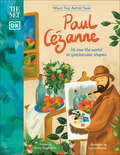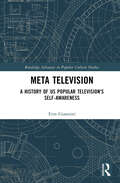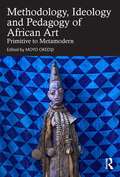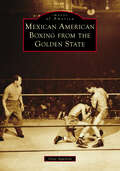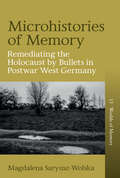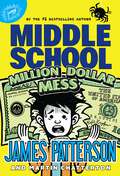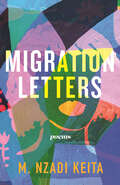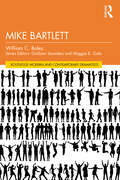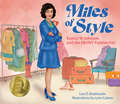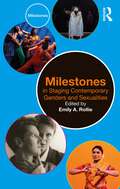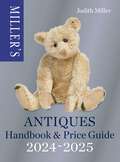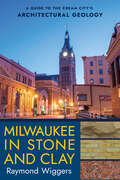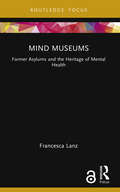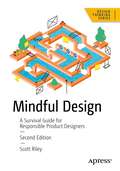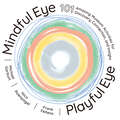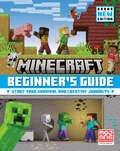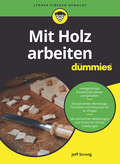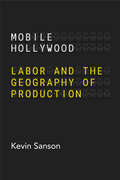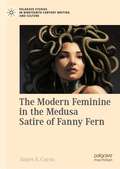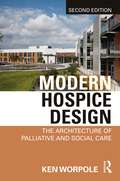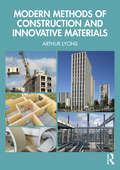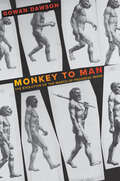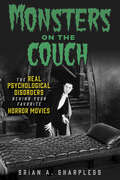- Table View
- List View
Mentoring History Teachers in the Secondary School: A Practical Guide (Mentoring Trainee and Early Career Teachers)
by Victoria Crooks Laura London Terry HaydnMentoring History Teachers in the Secondary School supports mentors to develop the knowledge, skills and understanding essential to the successful mentoring of beginning history teachers who are undertaking their initial teacher training or being inducted into the profession as early career teachers. The authors critically explore models of mentoring and place subject specificity at the heart of every chapter, offering practical mentoring strategies rooted in the best evidence and research from the history teaching community. This book is a vital source of encouragement and inspiration for all those involved in developing the next generation of history teachers, providing accessible summaries of history-specific thinking on a range of topics alongside mentoring support. Key topics include: • Understanding what being a subject-specific mentor of beginning history teachers involves. • Establishing a dialogic mentor-mentee relationship. • Supporting beginning teachers to develop the substantive and disciplinary knowledge they need to become excellent history teachers. • Guiding beginning history teachers through the lesson planning process. • Conducting subject-specific lesson observations and pre- and post-lesson discussions. • Supporting beginning history teachers to consider the purpose of history education and how they can navigate this in relation to values education, the use of ICT, and the teaching of controversial and sensitive issues. Mentoring History Teachers in the Secondary School offers an accessible and practical guide to mentoring beginning history teachers, with ready-to-use strategies to support and inspire both mentors and beginning teachers alike.
Messy Connections: Creating Atmospheres of Addiction Recovery Through Performance Practice (ISSN)
by Cathy SloanThis book examines performance practices that involve people in recovery from addiction, theorising such practices as recovery-engaged.Focusing on examples of practice from a growing movement of UK-based recovery arts practitioners and performers, it highlights a unique approach to performance that infuses an understanding of lived experiences of addiction and recovery with creative practice. It offers a philosophy of being in recovery that understands lived experience, and performance practice, as a dynamic system of interrelations with the human and nonhuman elements that make up the societal settings in which recovery communities struggle to exist. It thereby frames the process of recovery, and recovery-engaged performance, as an affective ecology – a system of messy connections. Building upon ideas from posthumanist research on addiction, cultural theory on identity and new materialist interpretations of performance practice, it considers how such contemporary theory might offer additional ways of thinking and doing arts practice with people affected by addiction. The discussion highlights the distinct aesthetics, ethics and politics of this area of performance practice.This study will be of great interest to students and scholars in Applied Theatre and Critical Arts and Mental Health studies.
The Met Paul Cézanne (What the Artist Saw)
by Amy GuglielmoSee the world through Paul Cézanne's eyes and be inspired to produce your own masterpieces.Have you ever wondered exactly what your favorite artists were looking at to make them draw, sculpt, or paint the way they did? In this charming illustrated series of books to keep and collect, created in full collaboration with The Metropolitan Museum of Art, you can see what they saw and be inspired to create your own artworks, too. In What the Artist Saw: Paul Cézanne meet the famous French painter. In this series, follow the artists' stories and find intriguing facts about their environments and key masterpieces. Then see what you can see and make your own art. Take a closer look at landscapes, or even yourself, with Vincent van Gogh. Try crafting a story in fabric like Faith Ringgold, or carve a woodblock print at home with Hokusai. Every book in this series is one to treasure and keep-perfect for budding young artists to explore exhibitions with, then continue their own artistic journeys.
Meta Television: A History of US Popular Television's Self-Awareness (Routledge Advances in Popular Culture Studies)
by Erin GianniniThe idea of metatextuality is frequently framed as a recent television development and often paired with the idea that it represents genre exhaustion. US television, however, with its early “live” performances and set-bound sitcoms, always suggested an element of self-awareness that easily shaded into metatextuality even in its earliest days. Meta Television thus traces the general history of US television’s metatextuality throughout television’s history, arguing that TV’s self-awareness is nothing new—and certainly not evidence of a period of aesthetic exhaustion—but instead is woven into both its past and present practice, elucidated through case studies featuring series from the 1970s to the present day—many of which have not been critically analyzed before—and the various ways they deploy metatext to both construct and deconstruct their narratives. Further, Meta Television asserts that this re- and de-construction of narrative and production isn’t just a reward to the savvy and/or knowledgeable viewer (or consumer), but seeks to make broader points about the media we consume—and how we consume it.This book explores the ways in which the current metatextual turn, in both the usual genres in which it appears (horror and sci-fi/fantasy) and its movement into drama and sitcom, represents the next turn in television’s inherent self-awareness. It traces this element throughout television’s history, growing from the more modest reflexivity of programs’ awareness of themselves, as created objects in a particular medium, to the more significant breaking of the fictive illusion and therefore the perceived distance between the audience and the series. Erin Giannini shows how the increased currency of metatextual television in the contemporary era can be tied to a viewership well-versed in its stories and production as well as able and willing to “talk back” via social media. If television reflects culture to a certain extent, this increased reflexivity mirrors that “responsive” audience as a consequence of the lack of distance that metafiction embraces.As Robert Stam traced the use—and implications—of reflexivity in film and literature, this book does the same for television, further problematizing John Ellis’s glance theory in terms of both production and spectatorship.
Methodology, Ideology and Pedagogy of African Art: Primitive to Metamodern
by Moyo OkedijiThis edited volume, including contributions from scholars with different areas of specialization, investigates a broad range of methodologies, ideologies and pedagogies focusing on the study of the art of Africa, using theoretical reflections and applications from primitivism to metamodernism. Chapters break the externally imposed boundaries of Africa-related works beyond the conventional fragments of traditional, contemporary and diaspora. The contributions are significantly broad in their methodologies, ideologies and pedagogical coverage; yet, they all address various aspects of African artistic creativity, demonstrating the possibilities for analytical experiments that art history presents to scholars of the discipline today. The Ìwà (character) of each approach is unique; nevertheless, each is useful toward a fuller understanding of African art studies as an independent aspect of art historical research that is a branch or bud of the larger family of art history. The volume respects, highlights and celebrates the distinctiveness of each methodical approach, recognizing its contribution to the overall character or Ìwà of African art studies. The book will be of interest to students in undergraduate or graduate, intermediate or advanced courses as well as scholars in art history and African studies.
Mexican American Boxing from the Golden State (Images of America)
by Gene AguileraThe Mexican American boxer is one who leaves it all in the ring. They have been described as devastating punchers, fearless fighters, and tough competitors by boxing fans, sportswriters, and commentators alike. Mexican American boxers have long carried a reputation in boxing circles as being the ultimate crowd-pleasers. In continuing that tradition, the dramatic testimonies of seven distinct, valiant, and dashing warriors from the Golden State of California are presented here in intricate detail: Aurelio Herrera, Art Aragon, Mando Ramos, Bobby Chacon, "Yaqui" Lopez, Arturo Frias, and Oscar Muniz. By exposing new generations to their action-packed stories, new life is breathed into these talented and gifted boxers, ensuring their fighting spirit and heartfelt memories will never die. This volume salutes these pioneers of Mexican American boxing for opening the doors for today's boxers.
Microhistories of Memory: Remediating the Holocaust by Bullets in Postwar West Germany (Worlds of Memory #13)
by Magdalena Saryusz-WolskaThe West German novel, radio play, and television series Through the Night (Am grünen Strand der Spree, 1955–1960), which depicts the mass shootings of Jews in the occupied Soviet Union during World War II, has gradually regained popularity in recent years. Originally circulated in postwar West Germany, the Holocaust representations embedded in this multi-medium work have shaped cultural memories up until today. Using numerous archival sources, Microhistories of Memory presents three comprehensive case studies to explore production, reception, and circulation of cultural memories, demonstrating the power of informal communication and providing behind-the-scenes insight into postwar memory culture in West Germany.
Middle School: Million Dollar Mess (Middle School #16)
by James Patterson Martin ChattertonIn this laugh-out-loud funny installment of a #1 New York Times bestselling series, Rafe inherits a million dollars—and a million problems—as he finds himself struggling to fit in at one of the snobbiest schools in the country. When Rafe discovers that he's inherited a fortune, it's not all good news. Sure, he gets an all-expenses-paid trip to glamorous Beverly Hills…. but he also has to go to school while he's in California. Blergh. And not just any school–St. Benedict&’s, the snobbiest of snobby establishments. You can bet your bottom dollar that Rafe doesn&’t exactly fit in. Toss in a ramshackle house Rafe&’s family has to live in before they can inherit the money and a group of bullies who make Miller the Killer look downright friendly, and this trip might be more trash than treasure. Rafe finds himself in the middle of a very big mess. Can he tidy his life up, or will he be sent packing?
Migration Letters: Poems (Raised Voices #5)
by M. Nzadi KeitaA poetry collection that reflects on intimate aspects of Black history, culture, and identity, revealing an uncommon gaze on working-class Philadelphia from the 1960s to the present dayIn 55 poems, Migration Letters straddles the personal and public with particular, photorealistic detail to identify what, over time, creating a home creates in ourselves. Drawn from her experiences of being born in Philadelphia into a Black family and a Black culture transported from the American South by the Great Migration, M. Nzadi Keita's poetry sparks a profoundly hybrid gaze of the visual and the sensory. Her lyrical fragments and sustained narrative plunge into the unsung aspects of Black culture and explore how Black Americans journey toward joy.Propelled by the conditions that motivated her family's migration north, the poems pull heavily from Keita's place in her family, communities, and the world at large. They testify to her time and circumstances growing up Black in Philadelphia on the periphery of the Civil Rights and Black Power movements. Each poem builds upon an inheritance of voices: a panoramic perspective of an Easter Sunday service in a Black church gives way to an account of psychic violence in a newly integrated school; the collective voices of a beauty salon's patrons fragment into memories of neighborhoods in North Philadelphia that have faded over time.Migration Letters strives to tell a story about Black people that radiates across generations and testifies to a world that, as Lucille Clifton wrote, &“has tried to kill [us] and has failed.&” They interrogate how one's present begins in the past, what we gain from barriers and boundaries, and what notions of progress energize our journey forward. Keita&’s poems intimately reveal how Black culture can be inherited and built upon complex relationships where love and pain are inextricably linked.
Mike Bartlett (Routledge Modern and Contemporary Dramatists)
by William C. BolesHailed as one of the most talented playwrights to have emerged in the late 2000s, Mike Bartlett's diverse range of plays strike at the heart of the various crises predominant in the early twenty-first century. Offering the first extensive examination of the plays and television series written by award winning playwright Mike Bartlett, this volume not only provides analysis of some of Bartlett’s best-known works (Cock, Doctor Foster, King Charles III, and Albion), but also includes new interviews with Bartlett and some of his closest and oft relied upon collaborators. In this book, Bartlett’s plays and television series are grouped together thematically, allowing the reader to observe the cross-pollination between his works on the stage and screen. The book also includes an introductory biographical chapter that discusses early influences on his writing (Harold Pinter, Mark Ravenhill, Tony Kushner, and Quentin Tarantino), his time in the Young Writers Programme at the Royal Court, and his work with the Apathists.Routledge Modern and Contemporary Dramatists is a series of innovative and exciting critical introductions to the work of internationally pioneering playwrights, giving undergraduate students an ideal point of entry into these key figures in modern drama.
Miles of Style: Eunice W. Johnson and the EBONY Fashion Fair
by Lisa D. BrathwaiteA chic biography about Eunice W. Johnson who brought elegant and contemporary fashion to Black America through the annual EBONY Fashion Fair!Eunice W. Johnson believed in the power of fashion and beauty to inspire people. After she and her husband, John H. Johnson, founded EBONY magazine, it quickly became the premiere lifestyle publication for mid-century Black readers. Among the many hats she wore, Eunice delighted in writing a fashion column describing the latest styles. In 1958, Eunice launched a project that would change fashion forever--the EBONY Fashion Fair. In towns and cities across the United States, Black models walked the runway in the freshest trends that season and Black attendees got to see people who looked like them in bright colors and haute couture. To make the Fashion Fair happen every year, Eunice negotiated with snobby fashion houses in Europe and navigated racism back home in the US, to acquire the most show-stopping styles for her show. Decades later, her name remains a watchword for glamour and elegance in the Black community. Winner of Lee & Low's New Voices award, Miles of Style celebrates a visionary who used her influence to showcase the strength and beauty of the Black community.
Milestones in Staging Contemporary Genders and Sexualities (Milestones)
by Emily A. RollieThis introduction to the staging of genders and sexualities across world theatre sets out a broad view of the subject by featuring plays and performance artists that shifted the conversation in their cultural, social, and historical moments.Designed for weekly use in theatre studies, dramatic literature, or gender and performance studies courses, these ten milestones highlight women and writers of the global majority, supporting and amplifying voices that are key to the field and some that have typically been overlooked. From Paula Vogel, Split Britches, and Young Jean Lee to Werewere Liking, Mahesh Dattani, Yvette Nolan, and more, the chapters place artists’ key works into conversation with one another, structurally offering an intersectional perspective on staging genders and sexualities.Milestones are a range of accessible textbooks, breaking down the need-to-know moments in the social, cultural, political, and artistic development of foundational subject areas.
Miller’s Antiques Handbook & Price Guide 2024-2025 (Miller's Antiques Handbook & Price Guide)
by Judith Miller***Miller's Antiques Handbook & Price Guide remains the essential and trusted guide to the antiques market. It has earned the reputation of being the book no dealer, collector or auctioneer should be without. Compiled by the late Judith Miller, world-renowned antiques expert and co-founder of the book, the guide features more than 8,000 antiques.Comprehensive sections cover Ceramics, Asian Antiques, Furniture, Glass, Silver and Metalwares, Jewellery and objets de vertu, Clocks and Watches, Books, Textiles, Toys, Decorative Arts and Modern Classics. Special features explain why one piece is worth more than another, show how to value an item and teach you to be your own valuer. Biographies of designers and factories give the background information you need to help date and value objects, while special 'Judith Picks' sections give fascinating background and valuation details for particularly interesting or unusual objects.
Milwaukee in Stone and Clay: A Guide to the Cream City's Architectural Geology
by Raymond WiggersMilwaukee in Stone and Clay follows directly in the footsteps of Raymond Wiggers's previous award-winning book, Chicago in Stone and Clay. It offers a wide-ranging look at the fascinating geology found in the building materials of Milwaukee County's architectural landmarks. And it reveals the intriguing and often surprising links between science, art, and engineering. Laid out in two main sections, the book first introduces the reader to the fundamentals of Milwaukee's geology and its amazing prehuman history, then provides a site-by-site tour guide. Written in an engaging, informal style, this work presents the first in-depth exploration of the interplay among the region's most architecturally significant sites, the materials they're made of, and the sediments and bedrock they're anchored in. Raymond Wiggers crafted Milwaukee in Stone and Clay as an informative and exciting overview of this city. His two decades of experience leading architectural-geology tours have demonstrated the popularity of this approach and the subject matter.
Mind Museums: Former Asylums and the Heritage of Mental Health (Museums in Focus)
by Francesca LanzMind Museums offer a fresh perspective on the heritage of mental health,bringing museums into sharp focus. Drawing on interdisciplinary approachesfrom architecture, museum and exhibition design, and heritage and museumstudies, it examines former psychiatric asylums that have been converted intomuseums.The book presents a comprehensive investigation of mind museums, thefirst of its kind in Europe, and explores their potential in raising awarenessand dismantling the stigma surrounding mental health. Through an indepthexamination of selected European examples, Lanz describes whatmind museums are and how they came to be. The innovative visitor studiescarried out at the Museo di Storia della Psichiatria in Reggio Emilia, whichare presented here, explore people’s encounters with mind museums andreveal the profound impact of such experiences. By uncovering the power ofthese heritage sites in facilitating discussions on mental health, civility, andcare, Lanz provides new insights into the emotive capacity of the museumand visitors’ reflexivity at place-based memory sites.Mind Museums will be of great interest to scholars and postgraduatelevelstudents engaged in the study of museums, heritage, exhibitiondesign, architecture, and mental health. It should also be of interest toheritage professionals, particularly those working in mind museums andother similar sites, such as prison museums and sites of conscience.
Mindful Design: A Survival Guide for Responsible Product Designers (Design Thinking)
by Scott RileyLearn to create seamless designs backed by a responsible understanding of the human mind. This new edition is fully updated and reworked to employ a realistic, challenging, and practical approach to interface design, presenting state of the art scientific studies in behavioral sciences, interface design and the psychology of design. All with modern, up-to-date examples and screenshots. The practical portion of this edition has been completely reworked, giving you the chance to follow along with a real, proven design process that has produced several successful products imbued with the principles of mindful, responsible design.You'll examine how human behavior can be used to integrate your product design into lifestyle, rather than interrupt it, and make decisions for the good of those that are using your product. You will also learn about the neurological aspects and limitations of human vision and perception; about our attachment to harmony and dissonance; and about our brain’s propensity towards pattern recognition and how we perceive the world around us. In the second half of the book, you’ll follow along with the key phases of a design project, implementing what you have learned in an end-to-end, practical setting. Design is a responsibility, but not enough designers understand the human mind or the process of thought. Mindful Design, Second Edition introduces the areas of brain science that matter to designers, and passionately explains how those areas affect each human’s day-to-day experiences with products and interfaces, providing a battle-tested toolkit to help you make responsible design decisions. What You'll Learn Review how attention and distraction work and the cost of attentional switchingUse Gestalt principles to communicate visual groupingEnsure your underlying models make sense to your audienceUse time, progression, and transition to create a compositionCarefully examine controlling behavior through reductionist and behaviorist motivation concepts Apply the theoretical knowledge to practical, mindful interface design Who This Book Is For The primary audience for this book is professional designers who wish to learn more about the human mind and how to apply that to their work. The book is also useful for design-focused product owners and startup founders who wish to apply ethical thinking to a team, or when bootstrapping their products. The secondary audience is design students who are either studying a ‘traditional’ visual design course, or a UX/interaction design course who have a desire to learn how they might be able to apply mindful design to their early careers. Finally, a tertiary audience for this book would be tutors involved in teaching design, or peripheral, courses who may wish to incorporate its teachings into their lectures, workshops or seminars.
Mindful Eye, Playful Eye: 101 Amazing Museum Activities for Discovery, Connection, and Insight
by Frank Feltens Michael Garbutt Nico RoenpagelExperience art and design as you've never experienced them before with 101 imaginative, mindfulness-based practices that will engage your senses, open your mind, and transform your next museum visitSwitch off your phone, take a deep breath, and prepare for adventure. Mindful Eye, Playful Eye invites readers on a thoughtful journey through museums, with 101 practices designed to nurture the development of attention, creativity, and compassion. This book encourages a playful and reflective approach to the museum experience of viewing art, sculptures, fossils, jewelry, aircraft, and more, including suggestions to:Imagine an object features prominently in a film or novel. What role does it play in a love story, thriller, and sci-fi?Pose to mirror a piece and consider the sensations that arise.Encounter as many objects as you can while holding your breath.Switch between scientific and empathic modes of viewing an object.Activities include instructions for both individual and partnered exploration. Whether frequenting a favorite museum or exploring an unfamiliar one, this book will enrich solo trips and add a unique element of connection to romantic or friend dates. Practices are divided into 5 categories:Body: explores how your body responds to museum objects.Vision: challenges established visual habits and encourages experimentation.Mind: focuses on thoughts and feelings that animate your inner world.Imagination: encourages you to imagine new ways of being.Action: transforms you into an art maker and performance artist.The practices can be performed in any museum in the world. Mindful Eye, Playful Eye empowers museumgoers to encounter museum collections, themselves, and each other with heightened awareness, centeredness, and a sense of unabashed joy.
Minecraft: Beginner's Guide (Minecraft)
by Mojang AB The Official Minecraft TeamDive into Minecraft headfirst with this all-new beginner&’s guide that will teach you everything you need to know for starting your Minecraft journey, whether that be in Survival mode or Creative. Are you new to Minecraft or still not quite getting the hang of it? Then this book is for you! Join characters such as Miss Hap, Sir Vival and Bill Ding on an adventure through the Overworld, to discover how you can ace your early game.Learn everything from what happens when you die and how to avoid it to how to feed yourself and where to find the cutest mobs. So what are you waiting for? Pick up the book and start your epic adventure!Full of fun and humor, this guide is perfect for kids of all ages.
Mit Holz arbeiten für Dummies (Für Dummies)
by Jeff StrongFertigen Sie Möbel und andere Dinge aus Holz an! Ob nützlich oder einfach dekorativ ? Ihrer Kreativität sind keine Grenzen gesetzt. Jeff Strong leitet Sie durch den Entstehungsprozess schöner Holzprodukte. Sie erfahren, welche Werkzeuge und Holzarten für die geplante Arbeit geeignet sind und welche Techniken Sie am besten einsetzen. Machen Sie Pläne für ein erfolgreiches Projekt oder legen Sie direkt los: mit den enthaltenen Schritt-für-Schritt-Anleitungen für Bücherregale, Tische, Schränkchen und Kommoden und erschaffen Sie schöne Gegenstände mit Ihren eigenen Händen. Mit diesem Buch erhalten Sie einen schnellen und gut verständlichen Zugang zum Handwerk der Holzbearbeitung.
Mobile Hollywood: Labor and the Geography of Production
by Kevin SansonA free ebook version of this title is available through Luminos, University of California Press's Open Access publishing program. Visit www.luminosoa.org to learn more. Contemporary film and television production is extraordinarily mobile. Filming large-scale studio productions in Atlanta, Budapest, London, Prague, or Australia's Gold Coast makes Hollywood jobs available to people and places far removed from Southern California—but it also requires individuals to uproot their lives as they travel around the world in pursuit of work. Drawing on interviews with a global contingent of film and television workers, Kevin Sanson weaves an analysis of the sheer scale and complexity of mobile production into a compelling account of the impact that mobility has had on job functions, working conditions, and personal lives. Mobile Hollywood captures how an expanded geography of production not only intensifies the often invisible pressures that production workers now face but also stretches the parameters of screen-media labor far beyond craftwork and creativity.
The Modern Feminine in the Medusa Satire of Fanny Fern (Palgrave Studies in Nineteenth-Century Writing and Culture)
by James E. CaronThe Modern Feminine in the Medusa Satire of Fanny Fern argues that Sara Parton and her literary alter ego, Fanny Fern, occupy a star-power position within the antebellum literary marketplace dominated by women authors of sentimental fiction, writers Nathaniel Hawthorne (in)famously called “the damn mob of scribbling women.” The Fanny Fern persona represents a nineteenth-century woman voicing the modern feminine within a laughter-provoking bourgeois carnival, a forerunner of Hélène Cixous’s laughing Medusa figure and her theory about écriture féminine. By advancing an innovative theory about an Anglo-American aesthetic, comic belles lettres, Caron explains the comic nuances of Parton’s persona, capable of both an amiable and a caustic satire. The book traces Parton’s burgeoning celebrity, analyzes her satires on cultural expectations of gendered behavior, and provides a close look at her variegated comic style. The book then makes two first-order conclusions: Parton not only offers a unique profile for antebellum women comic writers, but her Fanny Fern persona also anchors a potential genealogy of women comic writers and activists, down to the present day, who could fit Kate Clinton’s concept of fumerism, a feminist style of humor that fumes, that embraces the comic power of a Medusa satire.
Modern Hospice Design: The Architecture of Palliative and Social Care
by Ken WorpoleThe new edition of this acclaimed book comprehensively updates its timely advocacy of the need for good quality palliative care, today more necessary than ever. Rooted in the social history of the care of the elderly and terminally ill, Modern Hospice Design: The Architecture of Palliative and Social Care takes cognisance of the new conditions of social care in the 21st century, principally in the UK, Europe and North America. It does so with regard to the development of new building types, but also in response to new philosophies of palliative care and the status of the elderly and the dying. Benefitting from a clearer methodological approach and conceptual framework, the expanded book allows a broad section of readers to navigate the text more easily. At its core is a public discussion of a philosophy of design for providing care for the elderly and the vulnerable, taking the importance of architectural aesthetics, the use of quality materials, the porousness of design to the wider world, and the integration of indoor and outdoor spaces as part of the overall care environment. In doing so it advocates care settings that, in the words of Maggie Jencks whose life and ideas inspired the Maggie’s Centres, ‘rise to the occasion’. Including new chapters and new in-depth case studies, complete will full colour illustrations, this book is for architects and interior designers and their students, healthcare professionals, social care providers, estate and facility managers, hospital administrators and Healthcare Trust Boards.
Modern Methods of Construction and Innovative Materials
by Arthur LyonsThis new textbook has two main themes. The first is Modern Methods of Construction (MMC) which is the off-site manufacture of a wide spectrum of products, ranging from whole buildings to be transported onto site, down to smaller units or components for site integration. The second theme describes the innovation and progress towards carbon zero by the major generators of CO2 in the construction industry – namely cement, steel and masonry.The first section of the book describes and illustrates with photographs, the major forms of Modern Methods of Construction. These include fully completed 3D units, panelised systems, pods, sub-assemblies and on-site MMC. The section on Innovative Materials then describes a wide range of construction products which are entering into the built environment sector. Some new entrants are variants on well-established construction materials such as steel and concrete. Materials such as these will remain major construction materials for the foreseeable future, but their composition and manufacturing processes will inevitably have to change. Timber also will remain a major construction material, but sustainable sourcing is key and its utilisation as cross-lamination timber (CLT) or as modified timber is rapidly developing. As a result, students and practitioners must familiarise themselves with these materials, their composition, and various uses.The book goes on to describe variants of other traditional building products, such as glass, plastic and insulation, which are undergoing major developments leading towards enhanced environmental sustainability, as well as many emergent materials, some of which are likely to be significant in future. Modern Methods of Construction and Innovative Materials is the only book combining these important elements of the future of the industry in an easy-to-read guide for students and new practitioners. It is essential reading for anyone studying and working in the built environment, be they architects, construction managers, surveyors or engineers.
Monkey to Man: The Evolution of the March of Progress Image
by Gowan DawsonThe first book to examine the iconic depiction of evolution, the &“march of progress,&” and its role in shaping our understanding of how humans evolved We are all familiar with the &“march of progress,&” the representation of evolution that depicts a series of apelike creatures becoming progressively taller and more erect before finally reaching the upright human form. Its emphasis on linear progress has had a decisive impact on public understanding of evolution, yet the image contradicts modern scientific conceptions of evolution as complex and branching. This book is the first to examine the origins and history of this ubiquitous and hugely consequential illustration. In a story spanning more than a century, from Victorian Britain to America in the Space Age, Gowan Dawson traces the interconnected histories of the two most important versions of the image: the frontispiece to Thomas Henry Huxley&’s Evidence as to Man&’s Place in Nature (1863) and &“The Road to Homo Sapiens,&” a fold-out illustration in the best-selling book Early Man (1965). Dawson explores how the recurring appearances of this image pointed to shifting scientific and public perspectives on human evolution, as well as indicated novel artistic approaches and advancements in technology.
Monsters on the Couch: The Real Psychological Disorders Behind Your Favorite Horror Movies
by Brian A. SharplessHorror movies can reveal much more than we realize about psychological disorders—and clinical psychology has a lot to teach us about horror. Our fears—mortality, failure, loneliness—can be just as motivating as our wishes or desires. Horror movie characters uniquely reveal all of these to a wide audience. If explored in an honest and serious manner, our fears have the potential to teach us a great deal about ourselves, our culture, and certainly other people. From psychologist, researcher, and horror film enthusiast Brian A. Sharpless comes Monsters on the Couch, an exploration into the real-life psychological disorders behind famous horror movies. Accounts of clinical syndromes every bit as dramatic as those on the silver screen are juxtaposed with fascinating forays into the science and folklore behind our favorite movie monsters. Horror fans may be obsessed with vampires, werewolves, zombies, and the human replacements from Invasion of the Body Snatchers, but even many medical professions may not know about the corresponding conditions of Renfield's syndrome, clinical lycanthropy, Cotard's syndrome, and the misidentification delusions. Some of these disorders are surprisingly common in the general population. For instance, a number of people experience isolated sleep paralysis, a disorder implicated in ghost and alien abduction beliefs.As these tales unfold, readers not only learn state-of-the-art psychological science but also gain a better understanding of history, folklore, and how Hollywood often—but not always—gets it wrong when tackling these complex topics.
